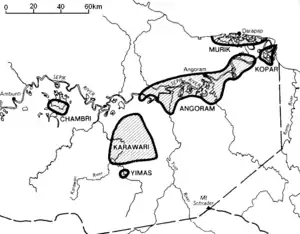Lower Sepik languages
The Lower Sepik a.k.a. Nor–Pondo languages are a small language family of East Sepik Province in northern Papua New Guinea. They were identified as a family by K Laumann in 1951 under the name Nor–Pondo, and included in Donald Laycock's now-defunct 1973 Sepik–Ramu family.
| Lower Sepik | |
|---|---|
| Nor–Pondo | |
| Geographic distribution | East Sepik Province, Papua New Guinea |
| Linguistic classification | a primary language family |
| Subdivisions |
|
| Glottolog | lowe1423 |
 | |
Classification
The original conception of the family, under the name Nor–Pondo, is as follows:
| Nor–Pondo |
| |||||||||||||||||||||
Malcolm Ross (2005) broke up the Nor branch (and thus renamed the family Lower Sepik) because Murik does not share the characteristic /p/s of the first- and second-person pronouns of Kopar and the Pondo languages, so the latter may form a group: Murik vs Kopar–Pondo. Ross classified Lower Sepik as one branch of a Ramu–Lower Sepik language family.
Foley (2005) tentatively proposes that Chambri and Angoram may be primary branches: Nor, Chambari, Karawari–Yimas, Angoram. Usher, following Foley, keeps Nor together and breaks up Pondo.[1] Neither accept the connection to Ramu.
Phonology
Except for Yimas-Karawari, Lower Sepik languages typically have the following six-vowel system.[4]
i u e ə o a
Yimas-Karawari has only four vowels.[4]
i u ə a
Proto-language
| Proto-Lower Sepik | |
|---|---|
| Reconstruction of | Lower Sepik languages |
Pronouns
The pronouns reconstructed for the proto-language are,
- Proto–Lower Sepik (Ross)
I *ama we two *ka-i, *ka-pia we few *(p)a-ŋk-i-t we all *a-i, *a-pia, *i-pi thou *nɨmi you two *ka-u, *ka-pua you few *(p)a-ŋk-u-t you all *a-u, *a-pu, *i-pu(a) s/he *mɨn they two *mɨnɨmp ? (M),
*mpɨ ? (F)they few *mɨŋkɨ-t they all *mump (M),
*pum (F)
- Proto-Nor–Pondo (Foley)
I *ama we two *ka-i, *ka-pa-i we few *(pa)ŋk-it we all *a-i, *a-pa-i, *(y)i-i, *(y)i-pa-i thou *mi you two *ka-u, *ka-pa-u you few *(pa)ŋk-ut you all *a-u, *a-pa-u, *(y)i-u, *(y)i-pa-u s/he *mən they two ? they few *mɨŋkɨ they all *mump ?
Lexicon
A phonological reconstruction of proto-Lower Sepik has been proposed by Foley (2005).[4] Foley's (2005) lexical reconstructions are provided below.
- Proto-Lower Sepik reconstructions by Foley (2005)
gloss proto-Lower Sepik Yimas Karawi Chambri Angrm Murik Kopar one *mb(w)ia- mpa- mba- mbwia- mbia- abe mbatep two *ri-pa- -rpal ripay -ri -(lɨ)par kobo kombari three *-ram -ramnaw -rianmaw -ram -elɨm keroŋgo keremɨŋ person *nor nar-maŋ yarmasɨnar noranan nor nor male *pon panmal panmari pondo puin woman *ŋay ŋay asay kaye nuŋor ŋai nana water *arɨm arɨm arɨm arɨm alɨm arɨm arɨm fire *awr awt awi ayɨr aluŋ awr awr sun tɨmal sɨmari sɨnmari mbwino akɨn akɨn moon *m(w)il ? mɨla tuŋkwi mwɨl mɨle karewan karep star awak suŋkwiɲcirim suŋgwi areɲjo moai kinaŋ canoe *kay kay kay ke ke gain kain house nam yam kurɨr nam iran indan village *num num imuŋka num num nomot numot breast *nɨŋgay nɨŋay ɲjay nɨŋke ŋge niŋgen niŋgin tooth *sisiŋk ? tɨrɨŋ sɨsɨŋ sraŋk sisiŋ asarap asirap blood *ya- yat yay yari ayakone yaran yuwaran bone *sariŋamp tanɨm tanɨm anamp salɨŋ sariŋib̩ sarekimp tongue *minɨŋ mɨɲɨŋ mumɨɲɨŋ tɨbulaniŋk mɨnɨŋ menɨŋ mimiŋ eye *tambri tuŋkuruŋ sampɨs sɨsiŋk tambli nabrin nambrin nose tɨkay ipun wambusu naŋɨm daur imbot leg *namuŋk pamuŋ pamuŋ namaŋk namuŋ namɨŋ hair wapwi wampi yawi mbwikmaley dwar ruar ear *kwand- kwantumuŋ kwandukas kukunam kwandum karekep kundot egg *awŋ awŋ yawŋ awŋk awŋ gaug awŋ leaf *nɨmpramp nɨmprɨm yimprɨm nɨmpramp namblum nabirɨk nɨmbiraŋ yesterday / tomorrow *ŋarɨŋ ŋarɨŋ arɨŋ namasɨnɨŋ nakɨmɨn ŋarɨŋ rari oar *(mɨ)naŋ muraŋ mɨnaŋ naŋk inap inaŋ naŋ betelnut *poruŋ patn payn muntɨkɨn parɨŋ porog puruŋ lime *awi(r) awi as ayɨr awer air air pig *numpran numpran impian numpran imbar nɨmbren nɨmbren crocodile manpa manpo ayi walami oramen uri snake *wakɨn wakɨn wakɨn wan paruŋ wakɨn ikun mosquito *naŋgun naŋkun yaŋkun naŋgun wawarɨn nauk nangɨt ground *andi anti anti nɨŋkrump andi agin andin feces *mɨndi mɨlɨm mɨnti muɲjar mɨndi mɨndɨn mɨndɨ hear *and- andɨ andu andɨ andɨ dɨn nda hit *di tupul kurar dɨɨ ti di nɨŋ eat *am(b) am(b) am(b) am(b) am(b) mɨn ma go *wa wa kuria kal wa on wa come *ya ya kurapia ya ya ya ya sit *sa tay sa nda sa nda big *kupa kɨpa kupa wupa kupa apo kapu cold *sarV- tarɨk sarɨk saruk popant sarapakin
For comparisons with the language isolate Tayap, see Tayap language#Classification.
Footnotes
- NewGuineaWorld - Lower Sepik River
- Foley, William A. (2018). "The Languages of the Sepik-Ramu Basin and Environs". In Palmer, Bill (ed.). The Languages and Linguistics of the New Guinea Area: A Comprehensive Guide. The World of Linguistics. Vol. 4. Berlin: De Gruyter Mouton. pp. 197–432. ISBN 978-3-11-028642-7.
- Lower Sepik River, New Guinea World
- Foley, William A. (2005). "Linguistic prehistory in the Sepik-Ramu basin". In Andrew Pawley; Robert Attenborough; Robin Hide; Jack Golson (eds.). Papuan pasts: cultural, linguistic and biological histories of Papuan-speaking peoples. Canberra: Pacific Linguistics. pp. 109–144. ISBN 0858835622. OCLC 67292782.
Further reading
- Proto-Lower-Sepik. TransNewGuinea.org. From (1) Foley, W.A. 1986. The Papuan languages of New Guinea, Cambridge: Cambridge University Press. ; (2) Foley, W.A. 1986. The Papuan languages of New Guinea, Cambridge: Cambridge University Press.
- Abbott, S. "Nor-Pondo lexicostatistical survey". In Adams, K., Lauck, L., Miedema, J., Welling, F., Stokhof, W., Flassy, D., Oguri, H., Collier, K., Gregerson, K., Phinnemore, T., Scorza, D., Davies, J., Comrie, B. and Abbott, S. editors, Papers in New Guinea Linguistics No. 22. A-63:313-338. Pacific Linguistics, The Australian National University, 1985. doi:10.15144/PL-A63.313
References
- Ross, Malcolm (2005). "Pronouns as a preliminary diagnostic for grouping Papuan languages". In Andrew Pawley; Robert Attenborough; Robin Hide; Jack Golson (eds.). Papuan pasts: cultural, linguistic and biological histories of Papuan-speaking peoples. Canberra: Pacific Linguistics. pp. 15–66. ISBN 0858835622. OCLC 67292782.